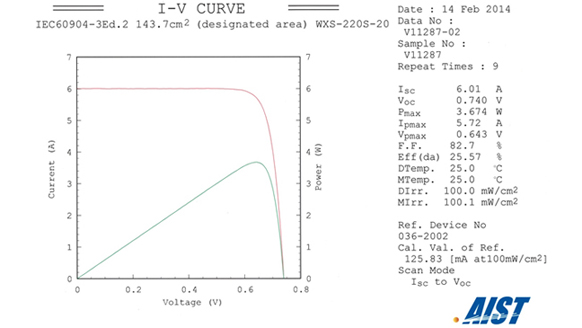
Nov 14, 2025
- Company
- Stories
- Technology
- EXPO 2025
- R&D
- Perovskite solar cells
- Panasonic GREEN IMPACT
- Editor's picks
- Hydrogen Energy Solutions

The high conversion efficiency was achieved at a research level using a HIT solar cell of a practical size.
Panasonic Corporation announced that it has achieved a conversion efficiency of 25.6% (cell area*3: 143.7 cm²) in its HIT(R) solar cells, a major increase over the previous world record for crystalline silicon-based solar cells.
The previous record*4 for the conversion efficiency of crystalline silicon-based solar cells of a practical size (100 cm² and over) was 24.7%, as announced by Panasonic in February 2013 (cell area: 101.8 cm²). The new record is 0.9 points higher and the first to break through the 25% barrier for practical size cells.
This new record is also an improvement of 0.6 points over the previous record for small area crystalline silicon-based solar cells (cell area: 4 cm²) of 25.0%*4,5.
The achievement of this new record was made possible by further development of Panasonic's proprietary heterojunction technology*6 to realize the high conversion efficiency and superior high temperature properties of the company's HIT solar cells as well as adopting a back-contact solar cell structure, with the electrodes on the back of the solar cell, which allows the more efficient utilization of sunlight.
Going forward, Panasonic will continue to pursue technology development of its HIT solar cells, aimed at realizing higher efficiency, lower costs and the more efficient use of resources, and will work towards mass production.
*HIT is a registered trademark of the Panasonic Group.
| Open-circuit voltage (Voc) | 0.740 V |
|---|---|
| Short circuit current (Isc)*12 | 6.01 A |
| Short circuit current density (Jsc)*12 | 41.8 mA/cm² |
| Fill factor (FF)*13 | 0.827 |
| Cell conversion efficiency | 25.6% |
| Cell area*3 | 143.7 cm² |
*1 According to research by Panasonic as of April 10, 2014, for non-concentrating silicon solar cells (regardless of cell area).
*2 Result of evaluations at the National Institute of Advanced Industrial Science and Technology (AIST).
*3 The cell area is the area opened by the masks.
*4 Judged from the "Solar cell efficiency tables (version 43)"
[Prog. Photovolt: Res. Appl. 2014; 22:1-9]
*5 University of New South Wales (Australia) (March 1999)
*6 Technology for junction formation required for solar cells that covers the silicon base surface with an amorphous silicon layer. Has the key feature of superior passivation to compensate for the many flaws around the silicon base surface area.
*7 Resistive loss is where positive and negative charges generated in the solar cell combine and are consequently lost inside the cell, lowering the current and voltage that can be output and accordingly decreasing the solar cell's output.
*8 The charge carrier is a particle of electricity containing an electron (negative) and a hole (positive). While the electron has a negative charge, the hole has a positive charge left from the disappearance of an electron.
*9 The temperature coefficient is a value expressing the ratio of conversion efficiency changes when the temperature rises by one degree.
*10 Value measured by Panasonic in assessing a similar cell. The previous HIT temperature coefficient was -0.29% per degree Celsius. The temperature coefficient of ordinary crystalline silicon solar cells is around -0.4 to -0.5% per degree Celcius. The lower the (absolute) value, the less the conversion efficiency drops under high temperatures.
*11 Open-circuit voltage (Voc) is the maximum voltage the cell can generate.
*12 The short circuit current (Isc) is the maximum current generated from a solar cell. The short circuit current density (Jsc) is the value found by dividing the Isc by the cell area.
*13 The fill factor (FF) is a value gained by dividing the maximum obtainable power of the solar cell by to the product of the open-circuit voltage and short-circuit current; the closer to 1 this is, the better the result.
The content in this website is accurate at the time of publication but may be subject to change without notice.
Please note therefore that these documents may not always contain the most up-to-date information.
Please note that German, Spanish and Chinese versions are machine translations, so the quality and accuracy may vary.